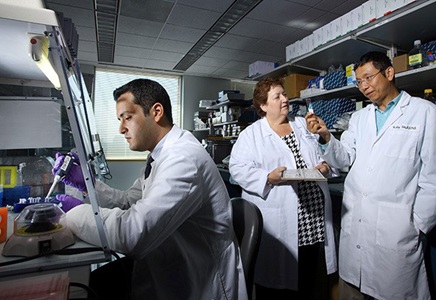Gestational Trophoblastic Disease
What You Need to Know Gestational Trophoblastic Disease (GTD)
- Gestational trophoblastic disease is the name given to a group of tumors that form during abnormal pregnancies.
- GTD is rare, affecting about one in every 1,000 pregnant women in the U.S.
- While some GTD tumors are malignant (cancerous) or have the potential to turn cancerous, the majority are benign (noncancerous).
- Many women treated for GTD can go on to have normal, healthy pregnancies in the future.
What is gestational trophoblastic disease?
Gestational trophoblastic disease (GTD) is the term given to a group of rare tumors that develop during the early stages of pregnancy. After conception, a woman’s body prepares for pregnancy by surrounding the newly fertilized egg or embryo with a layer of cells called the trophoblast. The trophoblast helps the embryo implant itself to the uterine wall. These cells also form a large part of the tissue that make up the placenta — the organ that supplies nutrients to a developing fetus. In GTD, there are abnormal changes in the trophoblast cells that cause tumors to develop.
Most GTD tumors are benign (noncancerous), but some have the potential to turn malignant (cancerous). GTD is usually classified into one of two categories:
-
Hydatidiform moles
-
Gestational trophoblastic neoplasia (GTN)
Hydatidiform Moles
A hydatidiform mole is also known as a molar pregnancy. In a molar pregnancy, there is a problem with the fertilized egg, and there is an overproduction of trophoblast tissue. This excess trophoblast tissue grows into abnormal masses that are usually benign but can sometimes turn cancerous. There are two types of hydatidform moles:
-
Partial molar pregnancy: The fertilized egg contains the normal set of maternal DNA but double the number of paternal DNA. Because of this, the embryo only partially develops and does not become a viable fetus.
-
Complete molar pregnancy: The fertilized egg has no maternal DNA and instead has two sets of paternal DNA. A fetus does not form.
Gestational Trophoblastic Neoplasia
There are several types of gestational trophoblastic neoplasia:
-
Choriocarcinoma: This cancerous tumor forms inside a pregnant woman’s uterus. Choriocarcinomas usually occur when growths from molar pregnancies turn cancerous. Rarely, choriocarcinomas form from tissue left in the uterus after a miscarriage, an abortion or the delivery of a healthy baby.
-
Invasive mole: Trophoblast cells form an abnormal mass that grows into the muscle layer of the uterus.
-
Placental-site trophoblastic tumor: This extremely rare, slow-growing tumor develops where the placenta attaches to the uterine wall. Placental-site trophoblastic tumors are often not discovered until years after a full-term pregnancy.
-
Epithelioid trophoblastic tumor: This extremely rare tumor’s progression mimics that of a placental-site trophoblastic tumor.
Gestational Trophoblastic Disease Prevention
There are no preventive medicines or treatments for GTD. The only way to prevent this very rare disease is to not become pregnant.
Gestational Trophoblastic Disease Causes and Risk Factors
Although it is a very rare disease, there are some factors that can increase a woman’s risk of developing GTD. They include:
-
Maternal age: If a woman becomes pregnant when she is younger than 20 or older than 35, she has a higher chance of developing gestational trophoblastic disease.
-
Previous molar pregnancy
-
History of miscarriage
Genetic Testing Aids Early Detection

Johns Hopkins researchers are developing new detection methods for gynecologic cancers. Learn more and discover how genetic testing for these cancers is saving lives.
Gestational Trophoblastic Disease Symptoms
Consult a doctor if you experience any/all of the following symptoms:
-
Bleeding or discharge not related to your periods (menstruation)
-
A larger-than-usual uterus while pregnant
-
Pain and/or mass in the pelvic area
-
Extreme bouts of nausea and vomiting
The symptoms listed above are also associated with many other gynecologic and pregnancy-related conditions. However, the only way to know if your symptoms are being caused by GTD is to have them evaluated by a doctor.
Gestational Trophoblastic Disease Diagnosis
Diagnosis of GTD includes a review of your medical history and a general physical exam. It may also include one or more of the following:
-
Internal pelvic exam: This is done to feel for any lumps or changes in the shape of the uterus.
-
Pap test (also called Pap smear): This test involves a microscopic exam of cells collected from the cervix, used to detect changes that may be cancer or may lead to cancer and to show noncancerous conditions, such as infection or inflammation.
-
Transvaginal ultrasound (also called ultrasonography): This ultrasound test uses a small instrument, called a transducer, that is placed in the vagina to look at the uterus and nearby tissue.
-
Blood tests: Doctors use blood samples to check the levels of certain hormones and other substances that may be impacted by the presence of GTD.
-
Urinalysis: GTD may alter the amount of sugar, protein, bacteria and certain hormones in a woman’s urine.
When cancer cells are found, other tests are used to see if the disease has spread from the uterus to other parts of the body. These procedures may include:
-
Spinal tap: In this procedure, the doctor inserts a needle into the patient’s spinal column to collect cerebrospinal fluid. This fluid is tested for high amounts of the hormone HCG. This is done in cases where doctors may suspect the GTD has spread to the brain or spinal cord.
-
Computed tomography (CT or CAT): These are scans of various sections of the abdomen (belly).
-
Chest X-rays
Gestational Trophoblastic Disease Treatment
Specific treatment for GTD will be determined by your doctor and based on:
-
Your overall health and medical history
-
Extent and type of GTD
-
Your tolerance for specific medications, procedures or therapies
-
Expectations for the course of the disease
-
Whether you wish to become pregnant in the future
Methods of treatment may include:
-
Surgery to remove tumors or affected organs
-
Chemotherapy: This is the use of anticancer drugs to treat cancerous cells. In most cases, chemotherapy works by interfering with the cancer cell's ability to grow or reproduce. Different groups of drugs work in different ways to fight cancer cells. Oncologists will recommend a treatment plan for each individual.
-
Hysterectomy: The uterus is removed in this surgery. Sometimes this is done with salpingo-oophorectomy, which is a surgery to remove the fallopian tubes and ovaries. Nearby lymph nodes and part of the vagina may also be removed.
-
Radiation therapy: This therapy uses high-energy radiation to kill cancer cells and shrink tumors.



